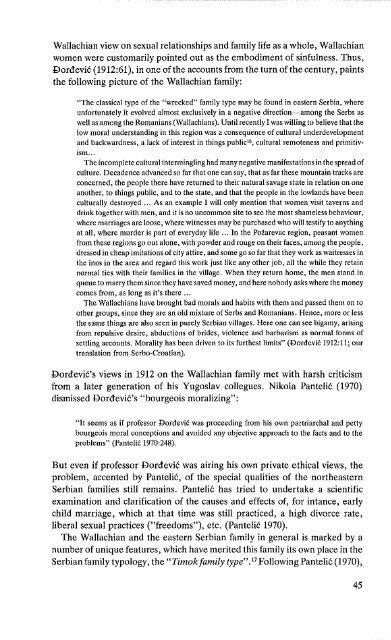Will they still be dancing? (1982)
Etnographic study of Romanians from East Serbia in Sweden in 1980s
Etnographic study of Romanians from East Serbia in Sweden in 1980s
You also want an ePaper? Increase the reach of your titles
YUMPU automatically turns print PDFs into web optimized ePapers that Google loves.
Wallachian view on sexual relationships and family life as a whole, Wallachian<br />
women were customarily pointed out as the embodiment of sinfulness. Thus,<br />
flordevic (1912:61), in one of the accounts from the turn of the century, paints<br />
the following picture of the Wallachian family:<br />
"The classical type of the "wrecked" family type may <strong>be</strong> found in eastern Serbia, where<br />
unfortunately it evolved almost exclusively in a negative direction-among the Serbs as<br />
well as among the Romanians (Wallachians). Until recentlyI was willing to <strong>be</strong>lieve that the<br />
low moral understanding in this region was a consequence of cultural underdevelopment<br />
and backwardness, a lack of interest in things public 16 , cultural remoteness and primitiv·<br />
ism...<br />
The incomplete cultural interminglinghad many negative manifestations in the spread of<br />
culture. Decadence advanced so far that one can say, that as far these mountain tracks are<br />
concerned, the people there have returned to their natural savage state in relation on one<br />
another, to things public, and to the state, and that the people in the lowlands have <strong>be</strong>en<br />
culturally destroyed ." As an example I will only mention that women visit taverns and<br />
drink together with men, and it is no uncommon site to see the most shameless <strong>be</strong>haviour,<br />
where marriages are loose, where witnesses may <strong>be</strong> purchased who wiII testify to anything<br />
at all, where murder is part of everyday life ... In the Pozarevac region, peasant women<br />
from these regions go out alone, with powder and rouge on their faces, among the people,<br />
dressed in cheap imitations ofcity attire, and some go so far that <strong>they</strong> work as waitresses in<br />
the inns in the area and regard this work just like any other job, all the while <strong>they</strong> retain<br />
normal ties with their families in the village. When <strong>they</strong> return home, the men stand in<br />
queue to marry them since <strong>they</strong> have saved money, and here nobody asks where the money<br />
comes from, as long as it's there ...<br />
The Wallachians have brought bad morals and habits with them and passed them on to<br />
other groups, since <strong>they</strong> are an old mixture of Serbs and Romanians. Hence, more or less<br />
the same things are also seen in purely Serbian villages. Here one can see bigamy, arising<br />
from repulsive desire, abductions of brides, violence and barbarism as normal forms of<br />
settling accounts. Morality has <strong>be</strong>en driven to its furthest limits" (-Dordevic 1912:11; our<br />
translation from Serbo-Croatian).<br />
flordevic's views in 1912 on the Wallachian family met with harsh criticism<br />
from a later generation of his Yugoslav collegues. Nikola Pantelic (1970)<br />
dismissed f)ordeviC's "bourgeois moralizing":<br />
"It seems as if professor -DordeviC was proceeding from his own partriarchal and petty<br />
bourgeois moral conceptions and avoided any objective approach to the facts and to the<br />
problems" (Pantelic 1970:248).<br />
But even if professor flordevic was airing his own private ethical views, the<br />
problem, accented by Pantelic, of the special qualities of the northeastern<br />
Serbian families <strong>still</strong> remains. Pantelic has tried to undertake a scientific<br />
examination and clarification of the causes and effects of, for intance, early<br />
child marriage, which at that time was <strong>still</strong> practiced, a high divorce rate,<br />
li<strong>be</strong>ral sexual practices ("freedoms"), etc. (Pantelic 1970).<br />
The Wallachian and the eastern Serbian family in general is marked by a<br />
num<strong>be</strong>r of unique features, which have merited this family its own place in the<br />
Serbian family typology, the"Timokfamily type". 17 Following Pantelic (1970),<br />
45
















